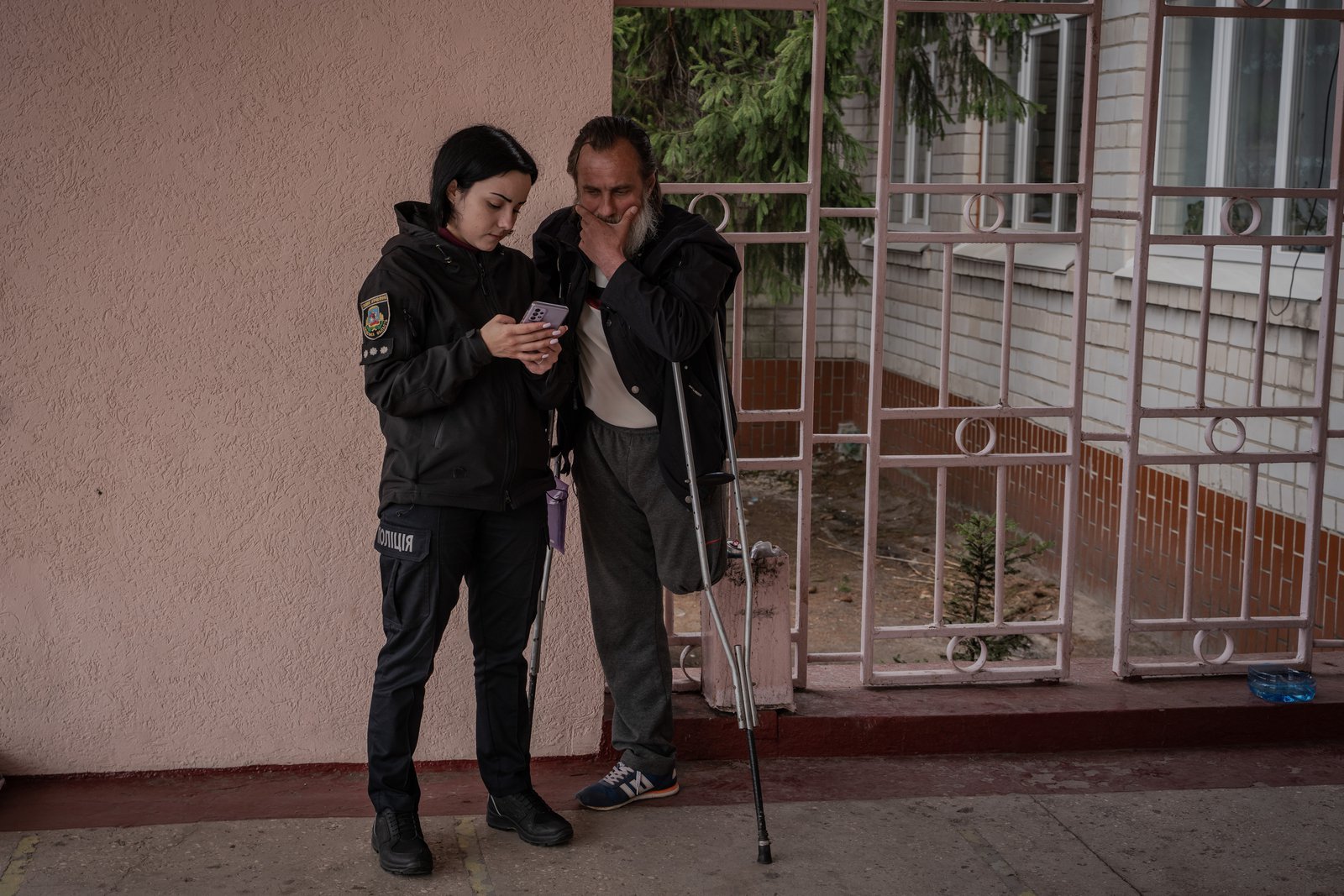The Man in a Black Bag. Exhuming Victims of War in Borodyanka
Oksana is scared to look so she says she would rather stay in the garden. She gets herself a chair from the house and waits until the job is done.
She just sits there silently taking drags from her Iqos electronic cigarette as her gaze wanders over the cellar and above the trees. The cherries are in bloom, and the earth is covered with an emerald carpet.
The garden is teeming with life — such an odd and absurdly inappropriate place for death. But death is right there, just under Oksana’s vegetable patches. Her brother, who was shot by the Russians, is being exhumed. The bullet crushed his skull leaving a bloody mess of what used to be his head.
Every day, more and more mass graves are being found in the town of Borodyanka about forty miles west of Kyiv. The communal enterprises are short-handed, the morgues are overstretched, and there is not enough equipment to support the operations. This story by TEXTY offers an insight into the exhumation and re-burying of the victims of war.
Text: Yaroslava Tymoshchuk. Photos: Marcin Suder
Читати українською
Red Sneaker, Size 43
The communal cemetery in Borodyanka is covered with fresh wreaths. When we first came here on April 26, we saw bodies being exhumed from a mass grave while the bodies of those who had died under the rubble were being prepared for burial. “This is not the first batch”, says the head of the local housing and communal services department (HCSD) Yuri Patoka: “There have been 18, but the count is growing by the day”. Following the de-occupation, new mass graves pop up like mushrooms after the rain: in cemeteries, in gardens around hospitals, in people’s vegetable gardens and orchards. When the village people start planting potatoes, every now and then the spade hits a dead body.
A few men in their thirties have gathered round a fresh grave at the cemetery. Their faces are grim, and they work in silence with eery efficiency. They change from time to time: one continues digging while the other steps away for a quick smoke. They are undoing a makeshift grave: five dead bodies had been carried by a few locals who had to work quickly under the shelling. They dig through the sandy soil for about one and half meters until the bodies, which were placed next to one another like sardines in a tin, start to appear. After a month in the ground, the decay does not leave much of the facial features — all you can see is a bog-colored bloody mess. However, there are still clothes, footwear, tattoos or an occasional ring on one's finger which are meticulously filed by the investigators under “special features” which somebody could use later to identify the victims.
Serhii Kovalchul, one of the group, is unearthing his brother Kolya. Being one year apart in age, they both worked as builders on different teams. They were about the same height and both wore size 43 shoes. When Kolya was shot by the Russians, he was wearing his brother’s shoes. This makes identification easier. Out of the five bodies only one looks familiar — the red sneaker immediately catches Serhii's eye.
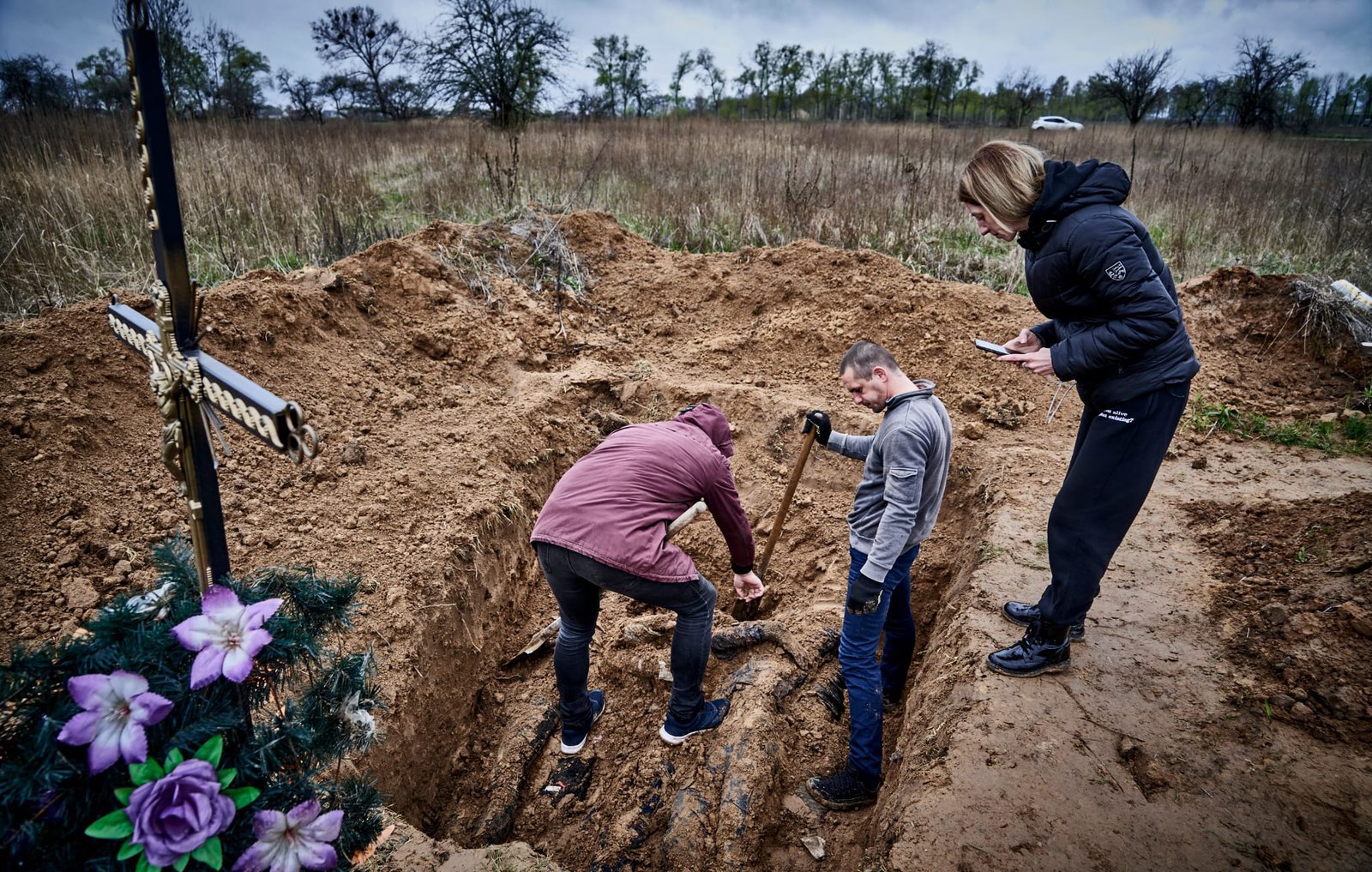
The diggers are overworked: the HCSD employs ten as it never needed more. According to the local police, forty-one people have been found under the rubble in Borodyanka, and 300 more — in the graves discovered after the de-occupation. The Borodyanka diggers are unearthing the graves which had been made during the occupation and making new ones for reburial. Those who book their services have to be patient as the wait is long. Serhii is not alone: some friends came to help, and he has brought a bottle of vodka and some apples as a thank-you gift.
THE DIGGERS ARE OVERWORKED: THE HCSD EMPLOYS TEN AS IT HAS NEVER NEEDED MORE
You cannot remove a body from a grave without the police present, so the men have to wait for the investigators to arrive. To find out what happened to Kolya, Serhii had to ask around the neighborhood since he had been hiding in a shelter with his mother. Kolya used to live with them.
He was told that on 4 March, his brother and three other guys got into a car and drove to the shops in the town center. Russian soldiers fired at the car to make it stop. Everyone got out and was ordered to put their hands in the air. This is what Serhii learned from one of the guys who survived the shooting: the bullets pierced his leg and pelvis, and now he is in a wheelchair.
“I was knocked down. As I was lying there, I saw your brother on the ground, pale as a sheet. He died quickly and did not suffer much”. Such were the words of the eyewitness who survived, says Serhii. How exactly Kolya was shot is still unknown. There is no information about other survivors either. Serhii did not know any of the guys.
Who moved the body from the shop to the church remains a mystery. On the morning of 5 March, the boy who eventually unearthed the mass grave, had found five dead bodies by the church. The priest lent his beaten Lada car and the bodies were taken to the cemetery. The boy who had found the bodies and brought them to the cemetery and one of the diggers told Serhii they had had to hurry. As the shelling began, they dropped their spades and took cover in the safety of their homes. In half an hour, the barrage was over, so they returned and put up a cross to mark the location.
The same boy told Serhii: “I may have buried your brother”. Serhii agreed that it might be possible as he had not seen Kolya for three weeks.
Now that the police are here, Serhii officially confirms the identity of the body: this is indeed his brother. One of the dead in the mass grave is no longer a John Doe. The police are accompanied by a vehicle operated by Cargo 200, the volunteer mission which helps transport the deceased to the morgue. The operations of the mission have been approved by the local council. The vehicles have been provided free of charge by a company from Chernivtsi. In addition, the company covers the fuel and the boarding expenses for two drivers, also from Bukovyna. A couple of volunteers from Kyiv region are assisting the drivers. They put on surgical masks and protective gloves and start removing the bodies from the grave, one by one.
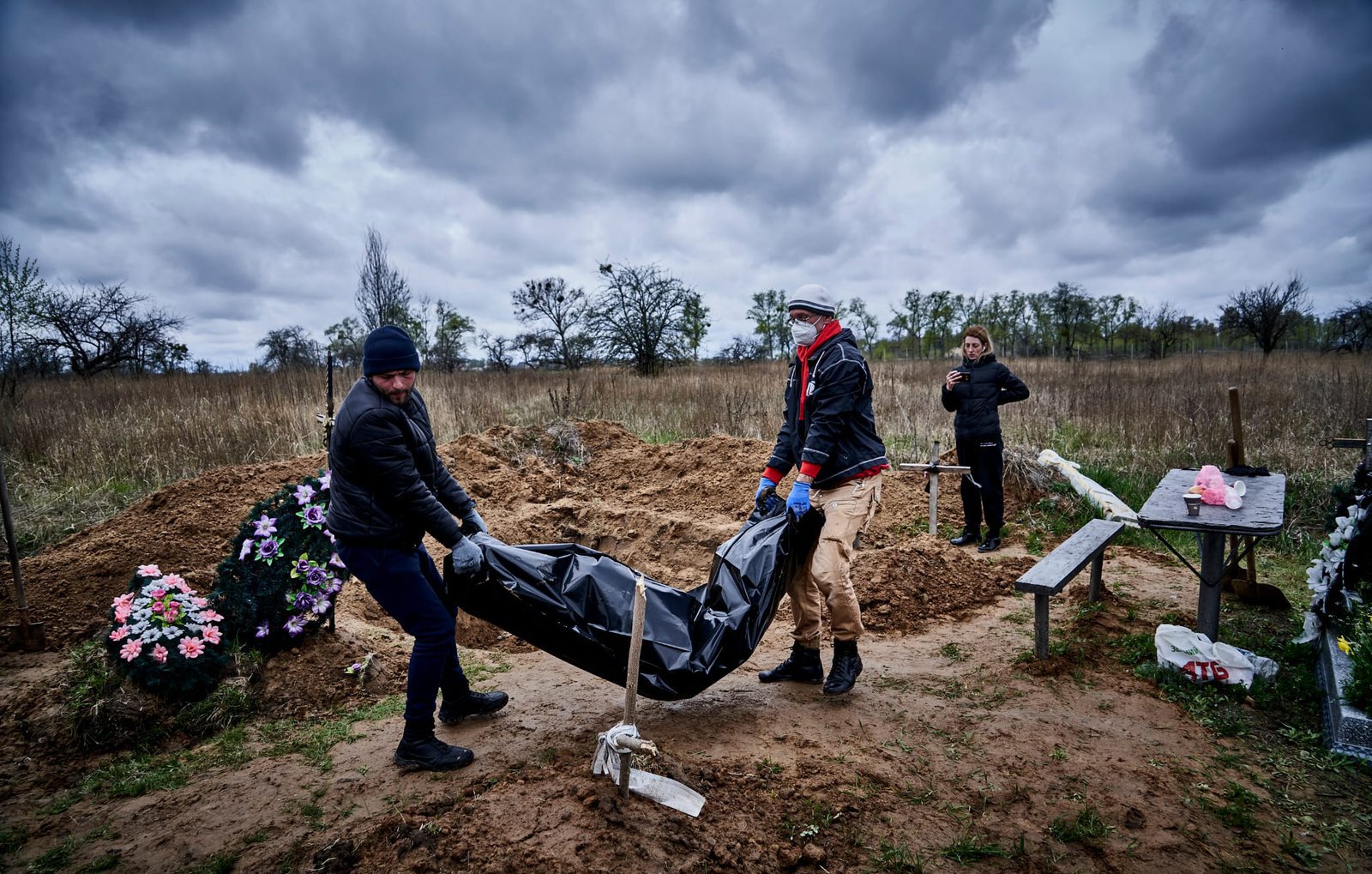
Policewoman Victoria Nemyrova is conducting an examination. She photographs each body and uses an app on her phone to record any characteristic features: a ring on a finger, a bandage on a leg or a tattoo. If bodies spent a month and a half in the ground, such features are scarce. For example, she says that it is difficult to positively identify the nature of the wound. The body itself seems to be stretched unnaturally, but the forensic medical expert who works at the morgue later explains that this is just an optical illusion: we are used to looking at people who walk upright, and now the perspective is different.
Once inspected, each body is packed into a sturdy black zipper bag. The bags must be numbered, but they cannot find a white marker. The surgical masks come in handy: the volunteers write numbers on them and attach them to each bag.
Serhii’s brother’s bag is No. 5. The brother of the deceased provides his passport details and gets the police officer’s phone number — she would later call him to say which morgue his brother's body was taken to. All the morgues are streched to the limit of their capacity, so it is the Chief Medical Examiner of the region who tells the police which morgue can accept the body in each particular case.
The guy who helped dig the grave refused to testify, but nobody insisted on his presence. Besides the bodies, there was also a pistol holster and a waist bag in the grave. However, the police did not accept them into evidence.
“Why didn't they take them?” somebody asks at the cemetery.
“This is evidence in a murder case, but the killers are in the wind” says Serhii's friend who is finishing an apple after unearthing the grave. “Everything gets lost in the fog of war” he adds.
The victims are unknown and so are their killers. Still, one more dead body from that grave would be identified a few days later.
Waiting for an Appointment with Death
It is 26 April. Oksana Tovkach is trying to get the attention of the people who work in the cemetery: “Please unearth my brother!” she says to the diggers and the head of the HCSD Yuri Patoka. She is growing impatient since she is the next in line after a week’s wait. The body of her brother, Volodymyr, lay in a makeshift grave for a month, and at first, Oksana worried that she would not be able to bury him within 40 days after his death. According to the Christian beliefs, this is when the dead person’s soul finds the final rest — either in heaven or in hell. Now, she just wants his body out of the ground.
The head of the HCSD promised to allocate communal diggers, but right now they are busy preparing 11 graves for the bodies expected from the morgue in Bila Tserkva. At first, Patoka gives Oksana a cold shoulder, but only when two foreign journalists, who are preparing to video the process, offer their digging services, does he reluctantly agree to assign two diggers to her case.
NOW, SHE JUST WANTS HIS BODY OUT OF THE GROUND
The man was buried in his own garden. Oksana, who was born and raised in Borodyanka and lived in the town of Vyshnevyi, was staying with her family in Ternopil oblast in March. On 12 March, she lost mobile communication with her family members — she had no idea what was happening in her town. On 1 April, after Borodyanka had been liberated by the Ukrainian army, her cousin told her that her brother had been killed on 16 March.
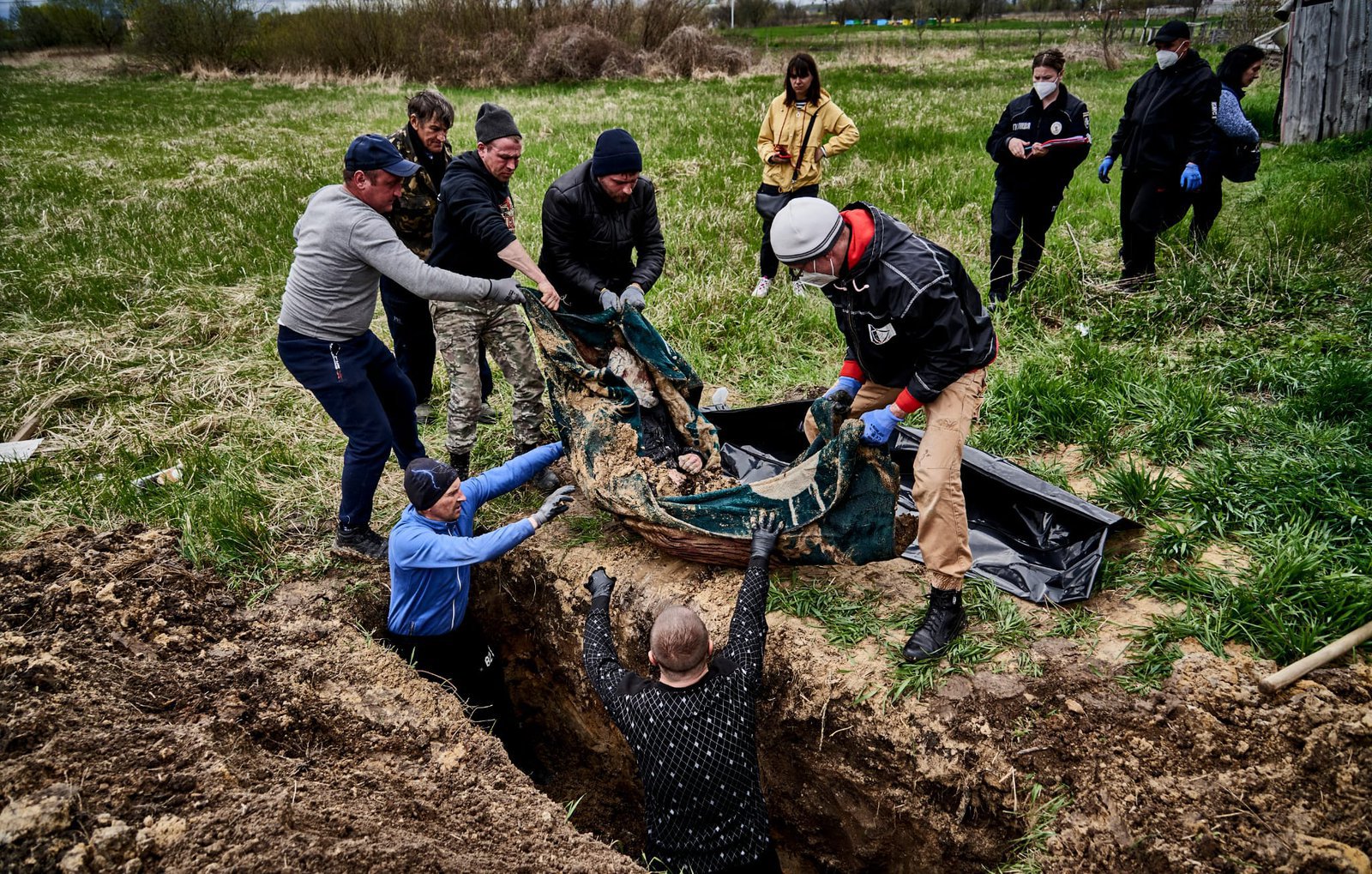
It was her neighbors who told her the date and the cause of death. The man was found shot near the bread factory. He had been there for three days until his cousin and her husband came to pick up the body. They first placed it in the house or in the shed, and dug a grave on the following day to the sound of artillery shells exploding nearby. After covering the bottom with hay, they buried him in the hole, marked the location with a cross and took a photo.
Oksana does not want to see the body come out of the ground so she says she’d rather keep her distance. She gets herself a chair from the house and waits until the job is done. She sits there taking drags from her Iqos electronic cigarette as her gaze wanders over the cellar and above the trees. The cherries are in bloom, and the earth is covered with an emerald carpet — such an odd and absurdly inappropriate place for death.
Death is not the only thing she must deal with: there are also formalities to be taken care of. When Oksana found out about her brother’s death, she did not know what to do in order to re-bury her family member. The looked for phone numbers of the prosecutor’s office, the police, and the HCSD on Borodyanka Facebook groups. The people shared their experience and told others about the procedure. There is waiting at every step: first you have to submit an exhumation request to the police, then wait till they execute a certificate of improper burial and, finally, wait till the diggers arrive. In addition to that, the applicants also have to arrange for a visit to the prosecutor's office to submit their statement of a war crime. The statements are processed by the prosecutors and forwarded to the Security Service of Ukraine (SBU).
SHE SITS THERE TAKING DRAGS FROM HER IQOS ELECTRONIC CIGARETTE AS HER GAZE WANDERS OVER THE CELLAR AND ABOVE THE TREES
The diggers finally get to it. The hole is two meters wide — ground water must be near because the body is drenched. The dead man was wrapped into a thick throw blanket — a green-colored plaid with a flowery pattern, the kind of thing to cuddle under while enjoying a movie. The throw blanket is soggy adding to the weight of the dead, but a team of five finally pulls the body out.
The shot to the head blew off half of his skull, and its right-hand side is a bloody mess. Oksana’s uncle identifies the deceased. Now it is time for the formalities: she has to provide her brother’s personal information and passport details and get the mobile number of the policewoman who will inform which morgue the body is to be collected from.
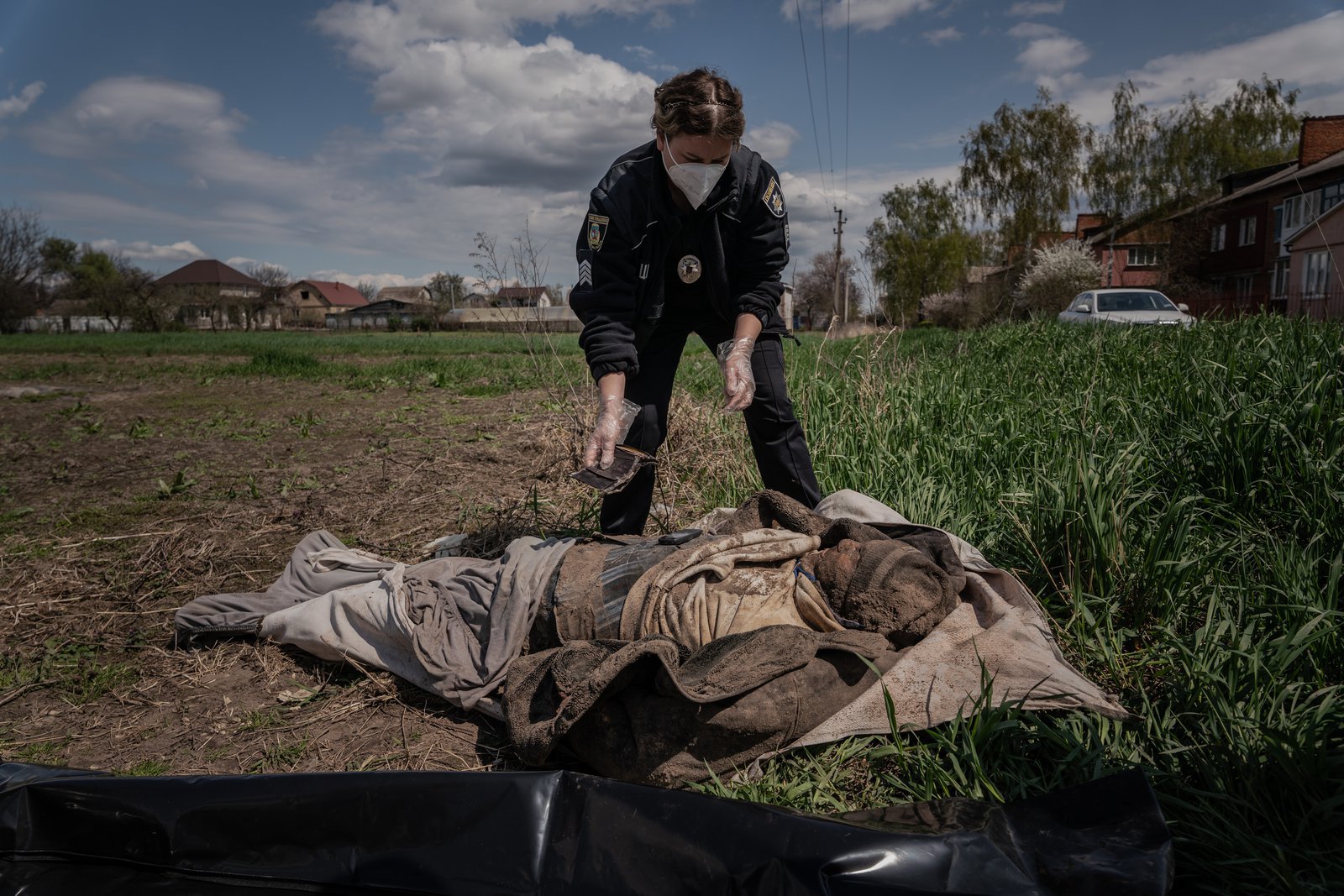
When the Cargo 200 vehicle carrying the body in a black bag exits the gate, Oksana starts to cry. Her uncle and she walk out onto the street and have a word with the neighbor. The man had recently buried his son who had died under the rubble in Borodyanka. The chat is over in a few minutes and everyone leaves the scene to mourn their loss in private.
Digging graves is not the most pleasant of jobs, and neither is examining bodies. However, Tetyana, the policewoman who examined and photographed Oksana’s brother’s body, has learned to deal with her emotions. We accompany her on a few such calls on different days. She sticks to the questions firmly and repeats them as necessary when people burst into tears or get carried away with their memories — this is the only way to get the job done.
Tetyana bends over a man’s body which has been unearthed from a vegetable garden. She pulls out a wallet: there is no cash, but there are some bank cards. The surname on the card is a lead: the neighbors say that his spouse could identify him although she might be out. There is definitely no love lost between them and the woman.
The lady is in: she is in her sixties, and her legs are badly sore — so much that you can feel the smell of rotten flesh. She identifies the deceased by the well-worn, but still neat clothes and his scant belongings. She is sobbing, but her tears do not touch the heart strings of the neighbor who decided to make the police officer company.
“Why did you steal my chickens when the Russians were here?” she barks at her as soon as they cross her threshold.
The police ask the ladies to sort out their issues after they finish with the official business, but the angry neighbor is not in the mood to back off. Finally, when Tetyana is done with the report, she turns to the lady and says: “If those chickens are not yours, could you possibly give them back?”.
The 11 Graves Which Got Names
Yuri Patoka, the head of HCSD says that four funerals a day in Borodyanka was considered extraordinary. Today, the number of bodies buried daily is far beyond that, but it no longer surprises anybody. Serhii, a member of Cargo 200 volunteer mission (the Budmontazhservis construction company from Chernivtsi has provided the vehicle and the drivers who are handling all the transportation of the bodies) concurs: in Kyiv region alone, they are moving 7 to 11 bodies to the morgues every day. They set off early, collect bodies through the day and deliver them for autopsy in the evening.
Before the war, people mostly died from natural causes such as age or illness. Since almost every death is violent these days, they all go through the medical examiner. Murder, shooting, air raid, shrapnel injury — all those things fall into the SVD category meaning ‘signs of violent death’.
Most of the people who died in their town were young boys shot in the head, says Patoka. The coroner from Bila Tserkva adds that this is also true for many other towns and villages, not only Borodyanka. The same things happened in the towns of Bucha and Makariv, the main sources of the bodies which end up in that morgue.
The diggers cannot unearth all the bodies fast enough while the morgues are stretched beyond their capacity and cannot hold the bodies for long. This is why all the 11 bodies which had been buried in Borodyanka cemetery as Johns and Janes Doe were identified a few days later. Not all of them were local: although the Cargo 200 vehicle had picked up the bodies in villages, they were all marked “from Borodyanka” in the morgue and that is where they were re-buried.
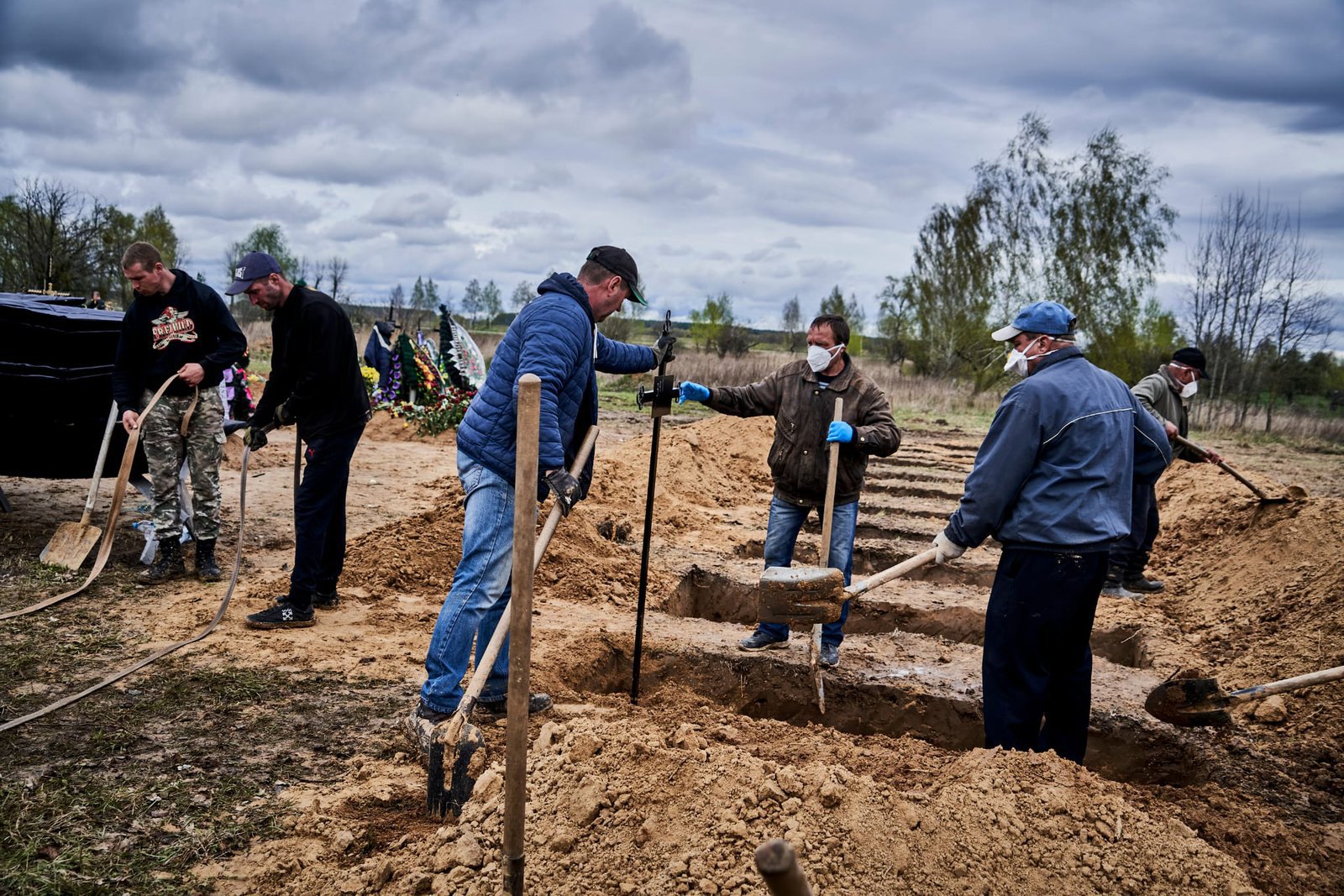
The number on the cross which marked the burial location matches the one on the black zipper bag (this data is also stored by the morgues along with DNA samples). More often than not, people cannot get to the morgues fast enough to identify the bodies. Some are still returning from abroad where they fled from the war while others do not know which morgue has the body and waste the precious time looking for it.
Therefore, the family members or the loved ones of the deceased who want to re-bury the bodies elsewhere have to re-apply for an exhumation permit. The empty graves do not stand empty for long as new bodies never stop coming.
To Identify the Body: the Morgue
It is +17 degrees outside, but the freezer which contains 35 bodies pending identification is not connected to the power supply. It is parked in the open on the hospital grounds near the morgue entrance. We are in Bila Tserkva where the 11 bodies identified after the re-burial have been taken.
“Even if the freezer had power, it would not be of much help since the chamber is not capable of maintaining the necessary temperature”, sadly admits Ihor Viktorovych, the local forensic medical expert. Ideally, the freezer should be able to run -15 — like the one in Boyarka, for example, but this is not the case.
The swinging door is wide open to at least provide some circulation. The air is filled with the smell of decay, flies are buzzing and maggots are crawling all around, the floor is stained with blood. To mitigate the situation, the forensic medical experts pack each body into two or three bags — at least they have enough of those.
The freezer was brought before the war to isolate the bodies of Covid-19 victims. Today, it is being used to store the bodies of the victims of war. Ihor Viktorovych says they have run out of storage: the designers of the morgue had no idea it would be operating at such capacity. While the war is taking its toll, people keep dying from natural causes.
Since 6 April, when the victims of war started coming to the Bila Tserkva morgue, it has received about 160 bodies. Although this number is lower compared to the other morgues of Kyiv oblast, it is still a lot of work. The dead age from 13 to 80, most of them male. The women are quite few, and no signs of rape have been found in the 160 victims. Boys aged 15 and upwards were shot in the head.
When the police file a report for each body, the forensic expert conducts a medical examination. If the body shows injuries which might have caused death, samples are taken by cutting patches of skin with the injuries off the body. Such cases do not necessitate an autopsy. However, if none are found, the body is autopsied. The cases which involve firearm wounds are handled by the regional bureau equipped with a forensic lab. The forensic medical experts also collect DNA samples which are handed over to the police with the rest of the evidence.
While we are talking, five or six people are already waiting for their turn to identify the victims. To find the right body in a numbered bag, you have to man-handle dozens of them and then load the body into a coffin — the aren’t enough workers at the morgue. The young policewoman who is tasked with filing out identification reports cannot start work since the bodies are not being moved.
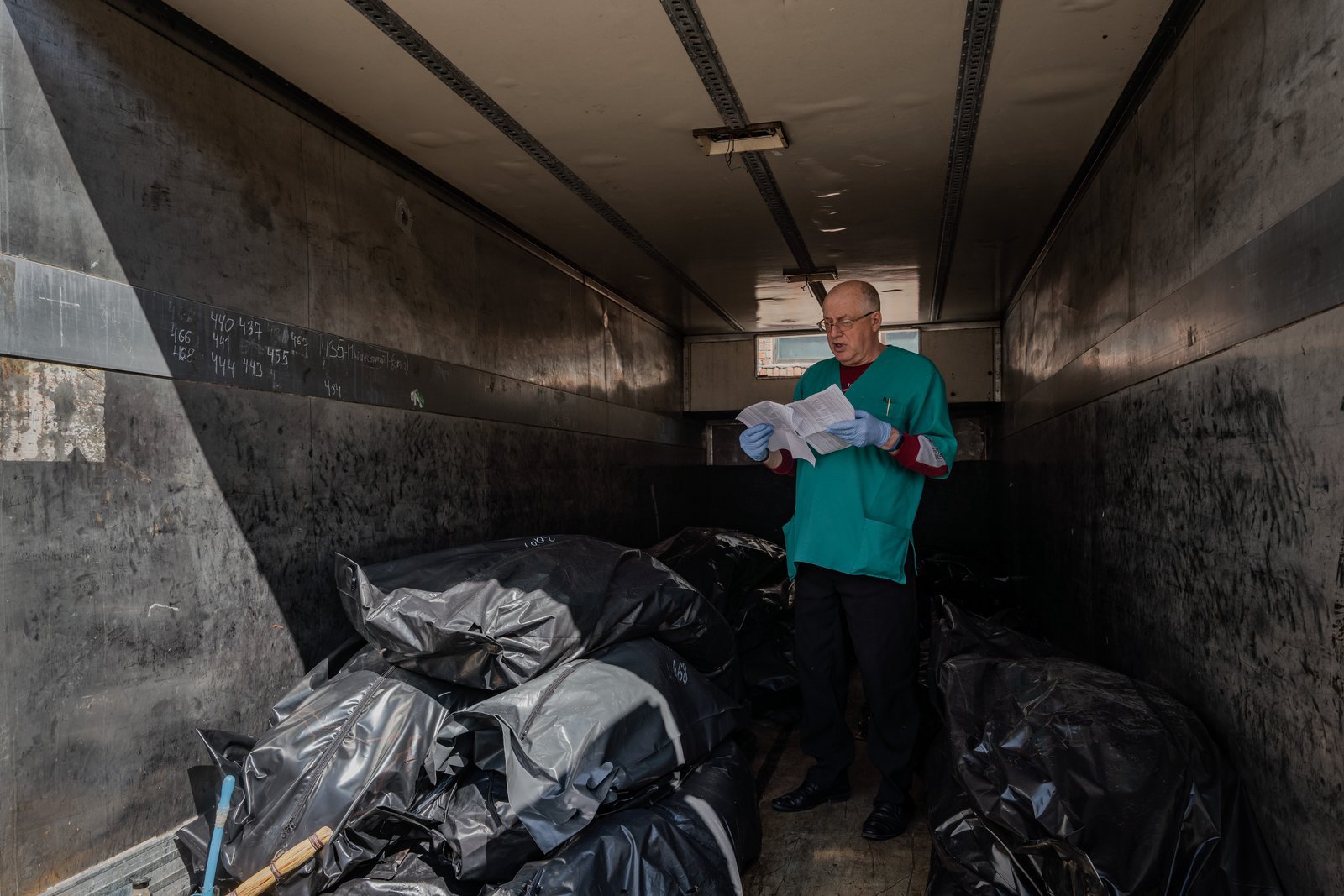
Up until recently, the police academy provided recruits for assistance, but they have left for the training camp. Although it was not their job, their help was invaluable since there is nobody else to do it. Whose job is it anyway? Nobody knows as the job has never existed. The men stacked up the numbered bags left and right and wrote the numbers on the walls to speed up the identification process.
Ihor makes a call asking somebody to help, and while he is waiting, the people who are strong enough pick up the bodies themselves.
A man in military fatigues drives up to the morgue in a van accompanied by his brothers in arms from the marine corps. Yesterday, the man identified his 22-year-old son: the boy had been shot in the head with his hands tied behind his back. He died in Bucha. The father opens up the bag one last time and his comrades help him put the bag into a coffin. A drop of brown liquid stains the snow-white lining of the coffin.
YESTERDAY, THE MAN IDENTIFIED HIS 22-YEAR-OLD SON: THE BOY HAD BEEN SHOT IN THE HEAD WITH HIS HANDS TIED BEHIND HIS BACK
To facilitate searching, the police publishes the photographs of the bodies removed from mass graves on “The Deceased of Bucha District” Telegram community.
“The body of an unidentified male, which was found on 08 April 2022 near the motor road towards Blystavytsya village, has been delivered to KRB of CMEO [Kyiv Regional Bureau of the Chief Medical Examiner’s Office]. The body was assigned No. 228”, such is a typical message posted on the group. If the person was carrying an ID, a name and a surname are added to the post. If you are searching for the body, you can contact the police at the number provided and be directed to the morgue which has control of the body.
It was that community that helped the man locate his son’s body. He does not know any details about the circumstances of his son’s death as he was away from home doing his military duty. The man picks up the death certificate, the final formality before the burial.
Ihor Viktorovych has worked at the morgue since 1987, but this is the first time he and the rest of his team are going through something like this. His job is delivering bad news, but he considers it a noble one. He helps the victims to rest in dignity with their names on the graves.
“During the World War II, people used to be buried in bulk, and nobody cared. Today, the Russians are showing exactly the same attitude: they never pick up their dead. Even in the hardest of times we still abide by the law. Dig them out, run a medical examination, collect DNA samples — that makes a difference.
Too bad some end up burnt up so badly there is nothing to collect. If nobody knows where and when the person could have burned, the documents will say “John Doe” or “Jane Doe”.
All that is left is a small pile of ash that fills up a small plastic bag”.
To Find the Son
It is 26 April. While graves are being unearthed on one side of the cemetery and bodies are being buried on the other, a woman is rushing about from grave to grave. She lives in a local village and has cycled here with a photo in hand. She is very sad she had missed the exhumation — the Cargo 200 team had already left. She rushes to attend every single exhumation and burial she hears about on local news.
The woman is showing the picture around to the head of the HCSD, Serhii's friends, to me when she finds out I am journalist — to everyone who is ready to listen to her story. In the picture, her two sons are siting at the table hugging each other by the shoulders. The photo is old and bleak, but it is the only that is left. One of them died before the full-scale war, but the mother still hopes to find the other. Oleh Stukalo, aged 45, is a local athlete and boxer. She last saw him on 9 March dressed in a black jacket. She has never seen him since.
“A big, strong man — have you seen one? Are you sure? He is about as tall as you, maybe a bit heavier”, she clings to the guy who is helping Serhii dig.
“No, there was nobody like that here”, says he.
The woman doesn't take no for an answer and asks me to show the pictures of the bodies exhumed from the grave. She looks long and hard, but does not recognize him among the dead. She grasps at the thought that her son might still be alive — what if he was captured by the Russians while they were retreating? He was not in the military, but that is still possible, isn't it?
“They picked the strong ones” — such is her hypothesis and her lifeline.
All this time the woman keeps her back straight staying fully focused on her search. But when bodies start coming from the morgue, the 11 black zipper bags, she starts to howl in despair as they are lowered into coffins, one by one.
A few days later, on 29 April, one of the bodies from the mass grave that Oleh Stukalo's mother had looked at so carefully to no avail, was finally identified. One more unknown dead body from the mass grave where the body of Serhii Kovalchuk’s brother had been found on 26 April got a name.
A one-legged man on crutches is standing in the doorway of the Borodyanka school. During the occupation, the Kadyrovites set fire to the police department and now the school houses the police office along with many other services. Victoria Nemyrova, the policewoman who took pictures of the bodies exhumed from the mass grave, is talking to the man. She shows him some photographs and he recognizes the person he is looking for — by the clothes and the snake tattoo.
This is the body of his son, and his search is finally over unlike that of Oleh Stukalo's mother. However, it is hardly a relief for either of them.
